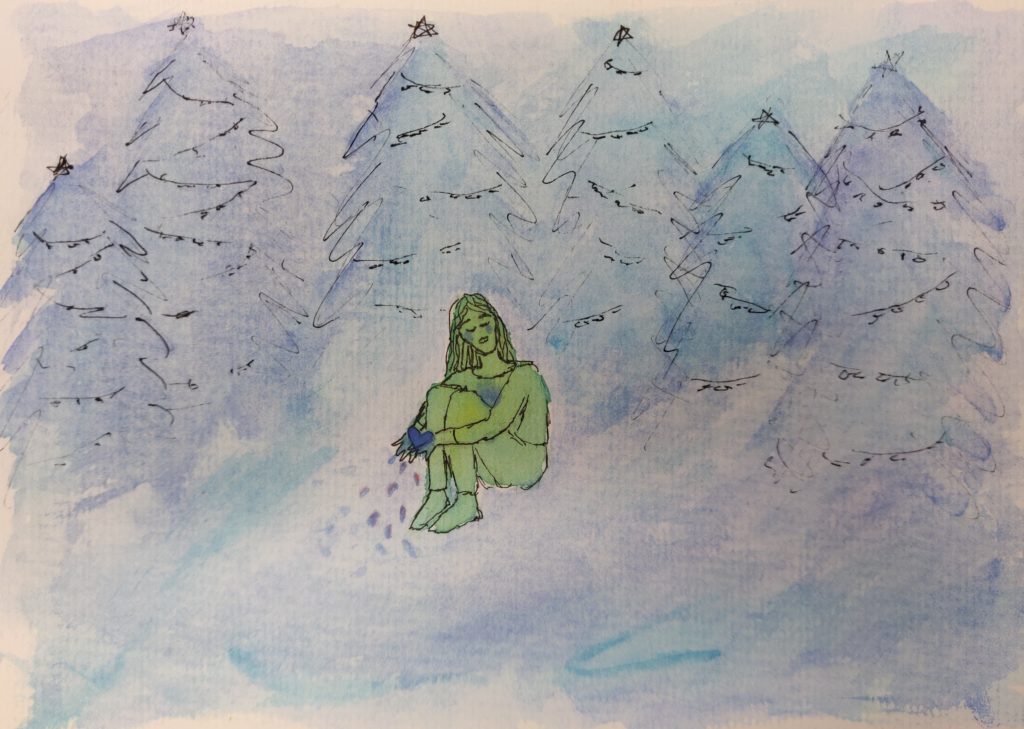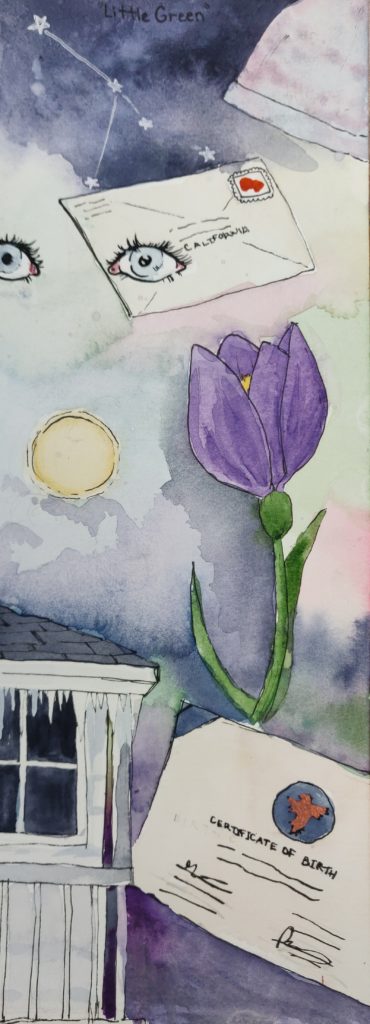The History and Popular Music of the ’70s class learned about Joni Mitchell’s emotionally raw record from 1971. Here are some of their reactions.
In Blue, Joni Mitchell expresses feelings of heartache through her confessional lyrics and passionate vocal performances. She recorded the album in a vulnerable state while breaking up with Graham Nash, going on several trips where she found other romances and facing the long-term mental effects of giving her infant daughter up for adoption years before. One can immediately sense this emotion by simply looking at her melancholic facial expression–drowned by a dark blue– on the album cover. She opens the first song, “All I Want,” with the line “I am on a lonely road and I am traveling,” revealing a sense of uncertainty from the very start– she goes back and forth between what she seeks in love and what she gets in reality. She utilizes contrasting dynamics between certain lines to highlight particular feelings. Her soft delivery in “Do you want to dance with me, baby?” juxtaposes her passionate articulation of “I want to be strong, I want to laugh long.” Throughout the album, she cannot help herself from being completely honest, even if doing so hurts others. Throughout the album, Mitchell represents the color blue in various ways to convey her different feelings of melancholy.
In the title track, Mitchell personifies blue in a fascinating way that illustrates her relationship with feelings of longing, sorrow and pain. Her choice to open each verse with blue makes the song feel like a letter to blue as if it were a person. She draws the comparison that “songs are like tattoos” because, like tattoos, songs leave traces of moments or feelings on people. As a result, she writes one to describe how the blue feeling affects and stays with her. In the bridge, she expresses ambivalence towards how people around her waste their lives away on “acid, booze, and ass.” She ends it with the line “blue, I love you,” which appreciates how her feelings of melancholy fill in the space that most people fill with sex and drugs. This idea also ties back into the second verse, where she describes ink filling space beneath the skin. One could interpret this idea as both continuing the tattoo metaphor or connecting it to the bridge, thinking about how sadness fills a more abstract space in Mitchell’s mind.
Although Mitchell represents the feeling of blue as longing and sorrow, she sees it as ultimately positive and necessary. To her, feeling blue means yearning for love and connections that she once had, but is now distant from. For example, in the song “California,” she paints a picture of herself on a trip in France, missing her home in California. In the bridge, she describes feeling lonesome as she walks through “streets full of strangers” and “gets the blues” as she thinks about her home, and what she misses while away. Here, blue embodies her feelings of homesickness and nostalgia. Although it causes her short-term pain, it allows her to appreciate and reminisce on the good feelings that she once felt. – Sebastian Moreno-Comstock
Blue is a beautiful look into Joni Mitchell’s personal life and emotions. She was one of the first recording artists to be truly vulnerable by expressing her emotions. Prior to this album, the majority of songs by female artists were written by men with surface level emotional content primarily focusing on relationships. They sing about their husbands, boyfriends and crushes, praising their relationships or missing past relationships. As catchy as these songs are, Joni’s music feels more genuine. She gives the listener a piece of herself to listen to. One of the common threads in this album is the concept of blue. Whether it is the color of the feeling, when you listen everything around you turns blue and a melancholy feeling settles in. The only song on the album without references to “blue” is “Little Green”—a song written about and for the daughter she gave up for adoption. The song brings feelings of hope mingled with sorrow. It discusses everything she will miss as her daughter grows up. She also notes that she was still a child and is growing up herself. For my response, I chose to have the whole piece in blue to show the frequent references but also the feelings I felt while listening. “River” is one of my favorite songs on the album and I think it has so many interesting details that you have to analyze. I added Christmas-type trees around her because it’s a little nod to “River” which has so many complex emotions. Joni is the only thing that is not blue. I painted her green because I think “Little Green” is as much for her as for her daughter. They are both growing up and she has hope for both of their futures. A really strong feeling of this album for me is that it feels like Joni is giving the listener a piece of her heart. In my painting she is offering the viewer her heart. – Pritam Khalsa
I wanted to do a response to the song more than the album as a whole. I used imagery from the song and made a bit of a narrative. I like the soft feeling with watercolors but it didn’t come out as saturated and I hoped it would. I liked working in the unusual paper format. – Zadie Niedergang



Both of these are nice reflections. It is tempting to see “Blue” as being about melancholy, but you might try listening to James Taylor’s “You Can Close Your Eyes,” which he wrote for Mitchell, and then “Blue” right after, which she wrote for him. “Blue” is her response to his song, her “foggy lullaby” in response to his lullaby, her way of saying she can’t close her eyes to his self-destructive tendencies.